The 32nd edition of the Olympic Games has been underway for days and is broadcast through the television signal in every corner of the planet, with numbers of viewers measured in billions. The most important sporting event in the world has developed for many decades an unbreakable commitment relationship with television, which has evolved into a two-way reality of multiple demands, which in turn have led to the technological take-off of broadcasts, with constant additions and innovations in every possible level, in a perpetual effort to improve the televised product, which has essentially become one and the same with the very concept of racing.
This two-way relationship is particularly simple and functional. On the one hand, television rights, which are managed by the International Olympic Committee, are the biggest obvious source of revenue for the games. The amounts are huge and constantly increasing. So, on the other hand, the requirement is one and absolutely clear:as impressive as possible results in quality and the variety of ways of approaching and utilizing technology, so that the presentation of the product is the best possible. It would not be an exaggeration, then, for someone to argue that the Olympic Games, in a depth of almost nine decades (from 1936 to the present day), have been the biggest "compulsory incentive" for continuous improvement and upgrading in the general sense of television broadcasting.
TV &OLYMPICS, A TWO-WAY RELATIONSHIP
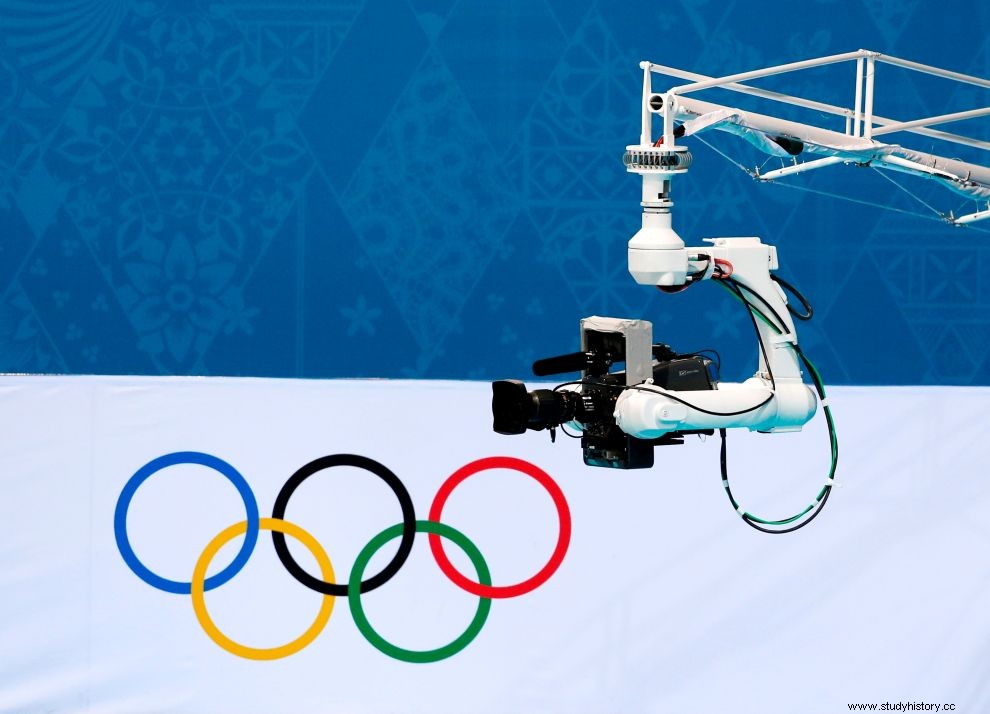
There are so many and different applications of innovations that make their appearance all these years in each new event, that we can comfortably claim that each separate Olympiad (every four years that intervenes between the games) is a guarantee for even more - most of them impressive - changes or additions to research, the planning, recording, completion and finally the implementation in the competition fortnight of the Olympics. And of course, all this technological "know how", in turn, becomes a compass for the general television landscape in a horizon so large, that automatically makes the relationship between television and the Olympic Games the most important in terms of the evolution itself.
Of course, technology advances at such a leaping pace that it is able to overtake even this very relationship that created between the games and television, since the possibilities of watching the Olympics (and not only) exceed the inches of the traditional television screen and can to now fit into other, smaller, but also easier to use, such as those of a mobile phone, a tablet or a laptop. Nevertheless, at least for now (and certainly for the foreseeable future), the flagship on a global scale, in terms of a solid and certainly huge core of those who watch the games, remains television, so that is where most of the attention of each company is focused. which is looking for new ways to combine the impressive with the practical, with an increasingly specialized way of television coverage, while satisfying every possible desire of the television viewer for immediate, quality and comprehensive information.
THE ROLE OF TECHNOLOGICAL DEVELOPMENT
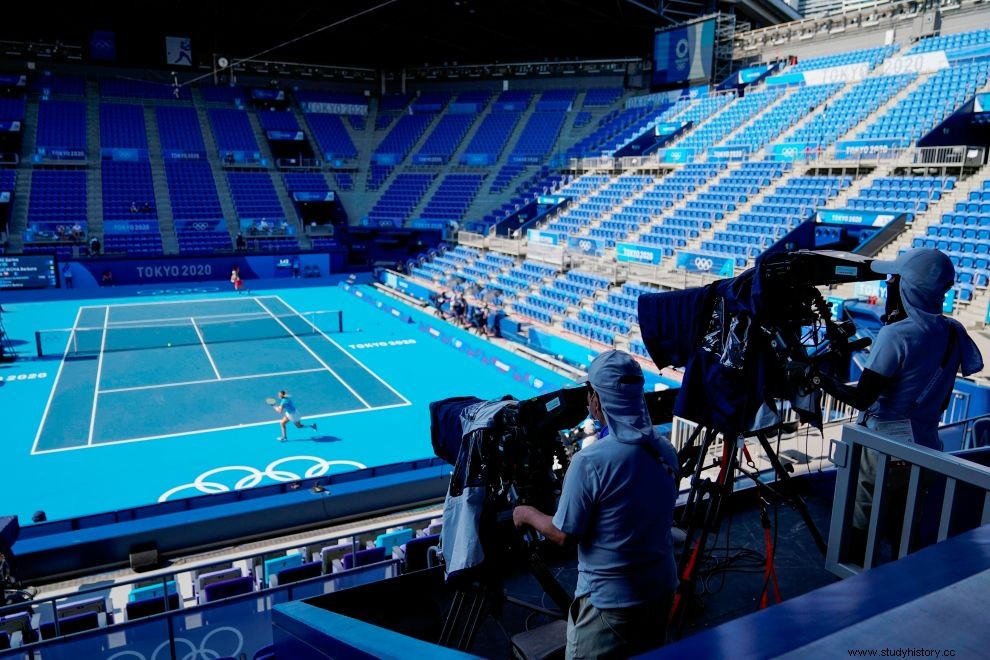
Throughout this course of eighty-five years, the changes that have taken place are countless at every level. The cameras, the speeds, the images, the frames, the machines, the consoles, the human resources, the microphones, the loudspeakers, the lenses, the timers, the shots, the modes of transmission, the transport of the material, all these and many more, evolved with an unprecedented logic of improvement, the main driving force of which was simply the requirements of the competitions and the IOC. This in itself tells us a lot about the beneficial effect that the Olympic Games had (and continue to have) on the refinement and development of quality in the field of television.
Not only as a technological effort (whose results are impressive anyway), but also as a more comprehensive consideration of technical support and journalistic presence behind and in front of the cameras. Before the appearance of television, the basic triptych on which the information of the Olympics was based was the radio, photographs and the written press. But none of these three media could faithfully reproduce the feeling of an athlete's movement. Only thecinema had this "luxury" and although it is a simple coincidence, the cinema and the first modern games were "born" at exactly the same time (1895 the cinema, 1896 the Athens Olympics).
THE FIRST STEPS IN THE 1936 GAMES
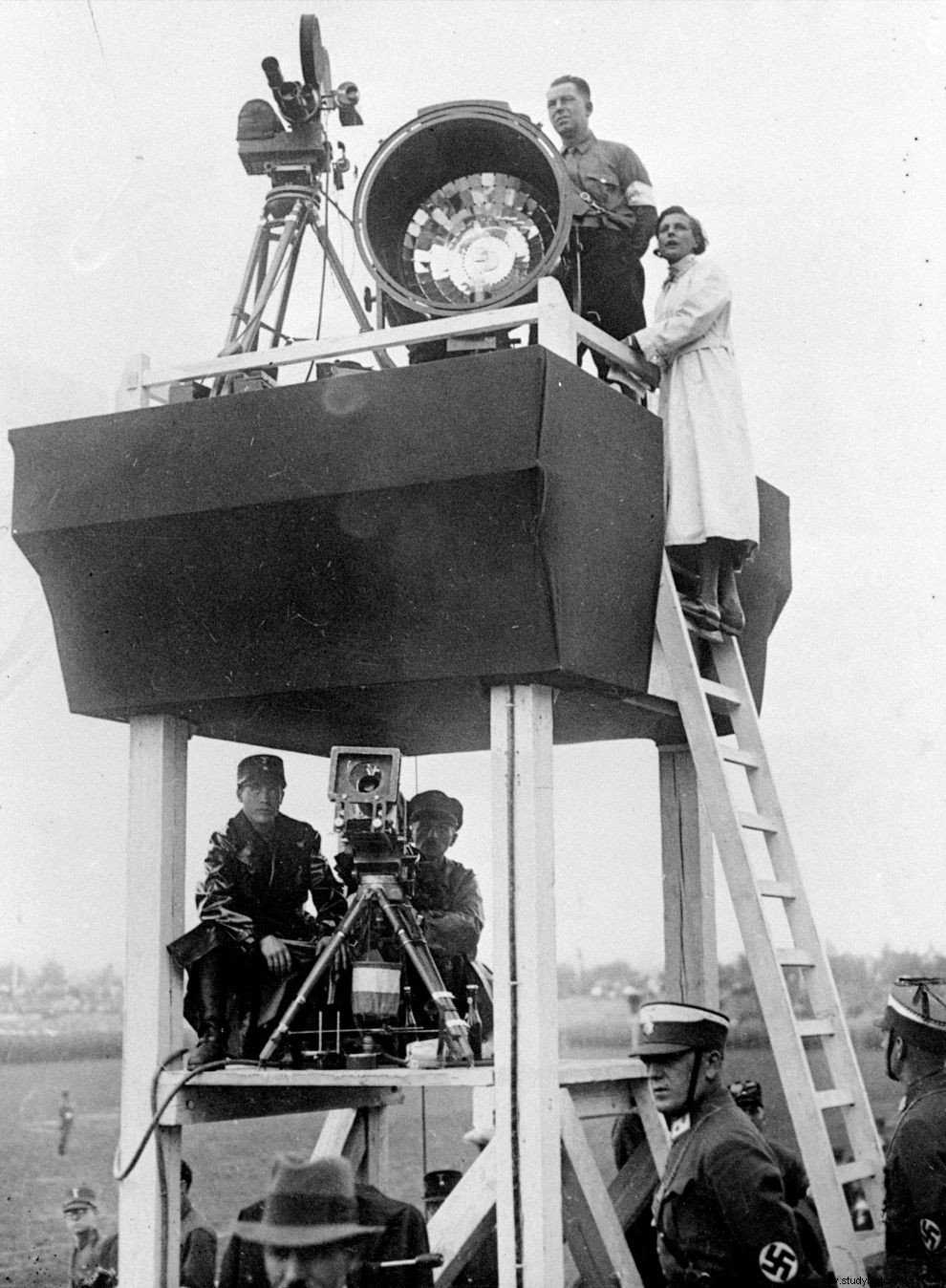
But the first time that television entered the equation, in a completely experimental form, was in 1936. Three video cameras and a closed-circuit projection system were used in 25 theaters, in which a total of 138 hours of the race program were shown and watched by 138,000 spectators. . At the same time, Zeppelins were used to transport the reels of film to the United States! However, the Olympiacos of '36 became widely known through the film "Olympia" by Leni Riefenstahl. The television broadcasts of 1936 were also enriched with the results of the matches on the screen. From 1928, in Amsterdam, we had measurements through film cameras whose resolution reached 1/100 of a second.
The German technicians managed to integrate the final times into the image, thus giving a complete presentation to the television viewer, who no longer needed to look for the results in the written press or wait to hear them on the radio. Tokyo, which had taken over the 1940 event, worked hard to improve television coverage, but in the end the games never took place due to World War II. Arriving in 1948 and London, we find the first serious attempt to televise the Olympics. Already in the 40s, television technology had developed rapidly.
THE "HIGH DEFINITION" OF 1948
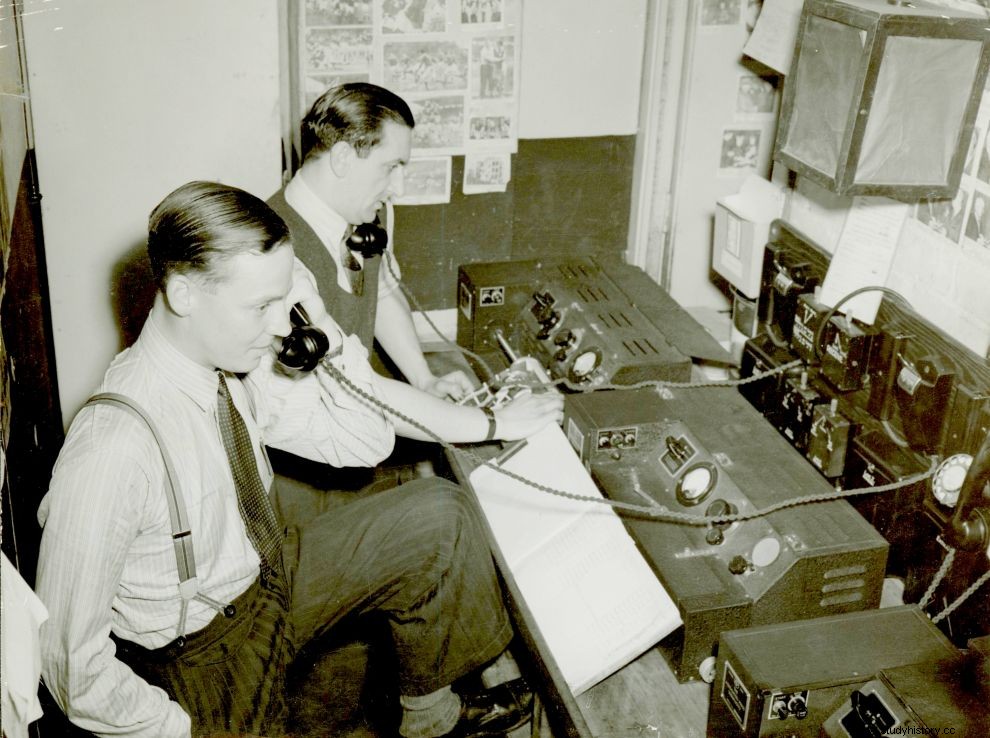
The pictorial cameras had been replaced by the decidedly more sophisticated CPS Emitron (a kind of super-pictorial), which had mounts with three built-in lenses, which greatly facilitated the work of its operators, although they continued to be very heavy. The British used a system built by EMI called 405-line for monochromatic, analogue television. The BBC had used this system for the first time in 1936 and it was the "high definition" of the time. The BBC television network numbered in 1948 approximately 80,000 receivers, the broadcasts that took place were taped and it is estimated that they were watched by over half a million television viewers, apparently only within Great Britain.
The same system as that of 1948 was used in the next two events, in Helsinki in 1952 and in Melbourne in 1956. In both cases, the transmissions were limited within borders, but with one important innovation. Who was she? Organizers would make copies of the reels they shot, with only the image, and send them abroad, where local television stations could write their own description on the original films and show them to their own audiences. At the same time, both in Helsinki , as well as in Melbourne, we had the first attempts to negotiate with major television networks in Europe and America, for the sale of television rights.
OMEGA AND THE FIRST PHOTO-FINISH
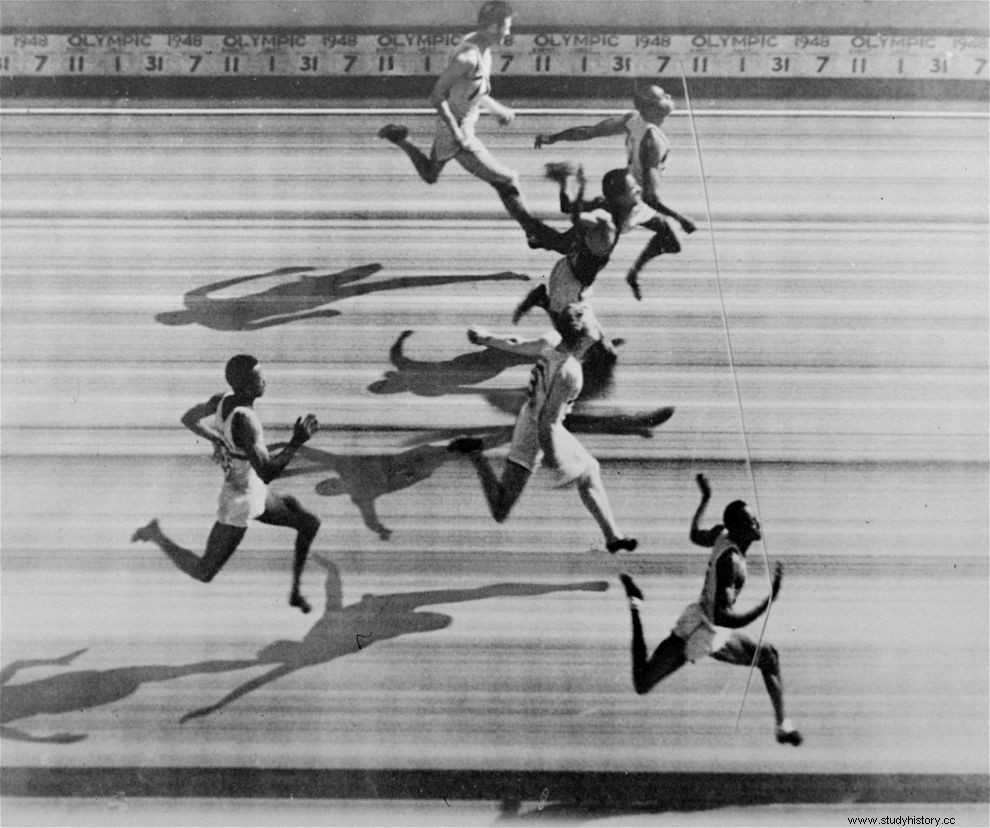
The talks broke down due to disagreements over the amounts requested by the organizing countries, but the foundations were laid for a new "philosophy" that was beginning to develop timidly, but making its intentions perfectly clear:televising turned the matches into a product, so it had to start its commercial disposition, which necessitated its improvement even more, with the aim of obtaining the most advantageous terms possible. Already, however, the innovations were succeeding one another. From London, in 1948, we had the cooperation of telecasts with OMEGA, through which a "station" in the history of the telecasts of the Olympic games arose.
The Swiss company connected the starter's gun with an electric sensor (for the invalid starts) and introduced for the finishes a complex for the time of the athlete photography system with multiple frames and high resolution, our familiar photo-finish. In Melbourne (1956) we had color film for the first time, although applications for television were still limited to black and white with the famous Arriflex cameras . Meanwhile, in addition to the telegraph and the telephone, the telex appeared, which greatly facilitated communications and was directly related to the development of the transfer of images, since photo-finish systems were connected to it, transferring together with the images, and the final ranking, which the foreign television networks incorporated into their own reels.
1960s, THE ENTRANCE TO THE ELECTRONIC AGE
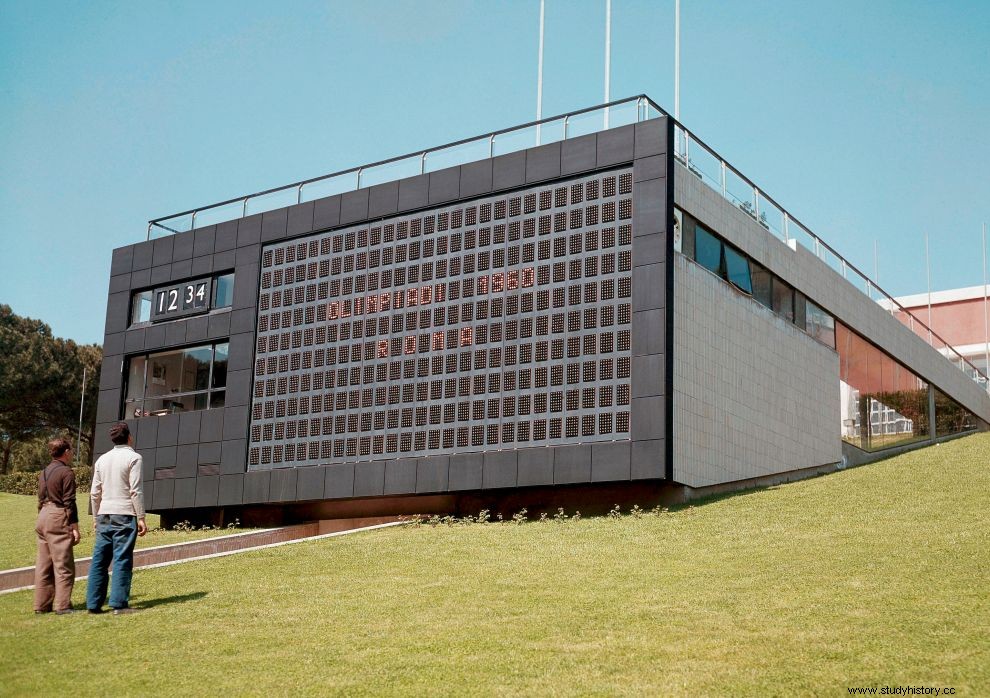
Entering the 1960s, a major change occurred, which changed the technological landscape to a great extent and fatally took with it the television coverage of first the Olympic games and then of all live broadcasts, sports or otherwise. This change was the entry into the electronic age. The aftermath was immediate and marked the real beginning of the two-way and completely dependent relationship between the Olympics and television. Logistical support solved countless practical problems and offered a variety of solutions to human resources, who were now beginning to feel like protagonists in an environment of technological superiority, which could comfortably achieve the two main demands:speed and quality.
In terms of television broadcast production, the tape recorder replaced the kinescope, which essentially meant that the broadcast could now be 100% live. Television companies took advantage of the new transistor technology and they were able to manufacture new receivers, clearly more functional than the old ones and - most importantly - cheaper in an unprecedented mass production, which skyrocketed the number of devices on a global scale, but mainly in America and Europe. So, in 1960, in Rome, everything was ready for a major step forward. For the first time, television broadcasts crossed national borders, as the matches were broadcast live in 18 European countries (and taped in the USA, Canada and Japan).
WORLD COVERAGE IN 1964 IN TOKYO
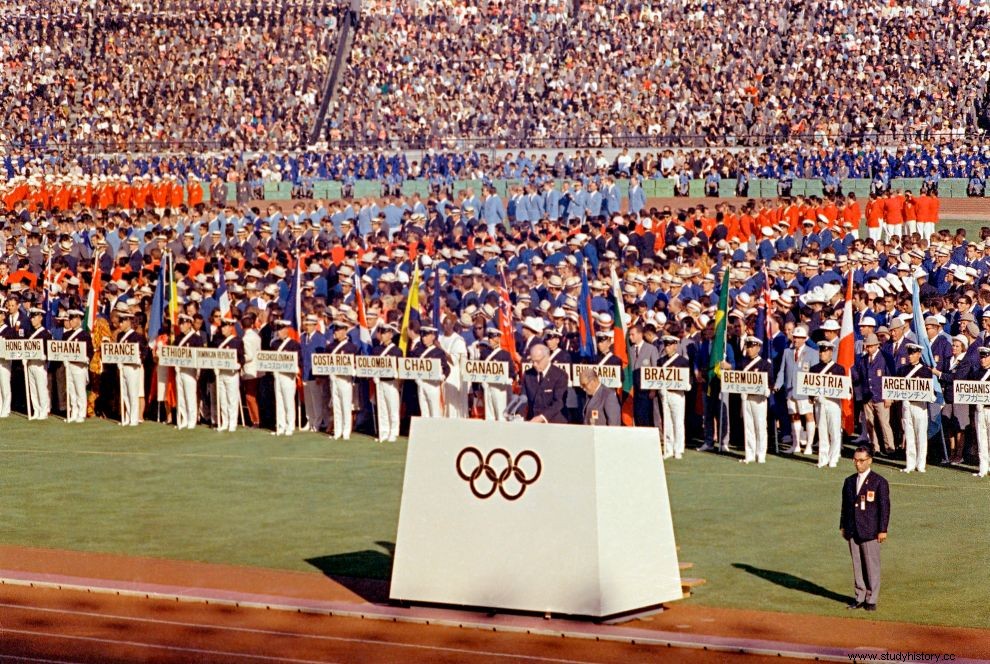
And four years later, in 1964 in Tokyo, we had the double revolution:live coverage now all over the world, due to the use of satellites for the first time to connect the signal, and the virgin appearance of the color image! It is no coincidence that the Tokyo event was nicknamed the "TV Olympics". The matches were broadcast live in the US via Syncom 3 (an artificial geosynchronous orbit satellite) and respectively in Europe via Relay 1. Eight of the sports were broadcast in color (albeit only within Japan), including judo, volleyball and gymnastics, using a new Toshiba color transmission system.
It was also the first time that the opening and closing ceremonies were broadcast in color, while the 1964 games marked another very important change, which in turn had a huge impact on television itself. The context of the Olympic theme ceased to be strictly informative and began to acquire an entertainment identity. This shift was officially completed in 1968 in Mexico City. The first event where all the coverage was done by satellite and with a color image, now all over the world. It was the turning point that defined the new era of television broadcasts, as we know them to this day in their general outline (after the changes continued in the following years as we will see below).
LIVE TIMING ON SCREEN
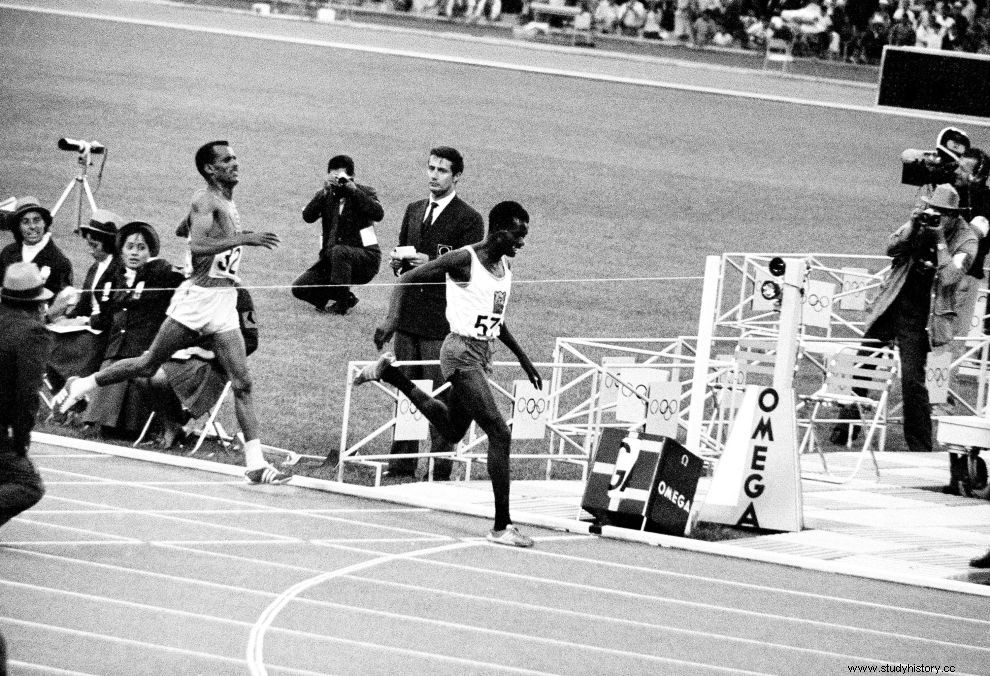
The 1968 event brought many innovations and set new records. For the first time, the total number of those who watched the games exceeded half a billion, while the gap between the countries that were represented at the Olympics and the countries that broadcast them began to visibly close. That is, in Mexico, we had athletes from 112 states and a television signal in 70 of them. This difference, from that point on, would continually decrease, until we reached the complete reversal. The system used in 1968 was Intelsat, with NASA's experimental satellite, ATS-3. For the first time the signal was converted to PAL to serve European countries.
They were also the first games in which every athlete was measured or timed automatically and electronically. OMEGA with its new system, Omegascope , gave the television viewers the opportunity to watch the progress of time live on their screen, simultaneously with the progress of the race. The Omegascope, completely revolutionary for its time, consisted of a special gun for the trigger, a base with photocells on the termination, a photographic timer, a synchronized clock and a digital timer connected to a camera to play back the images on television.
FROM TERRORISTS TO REPLAY
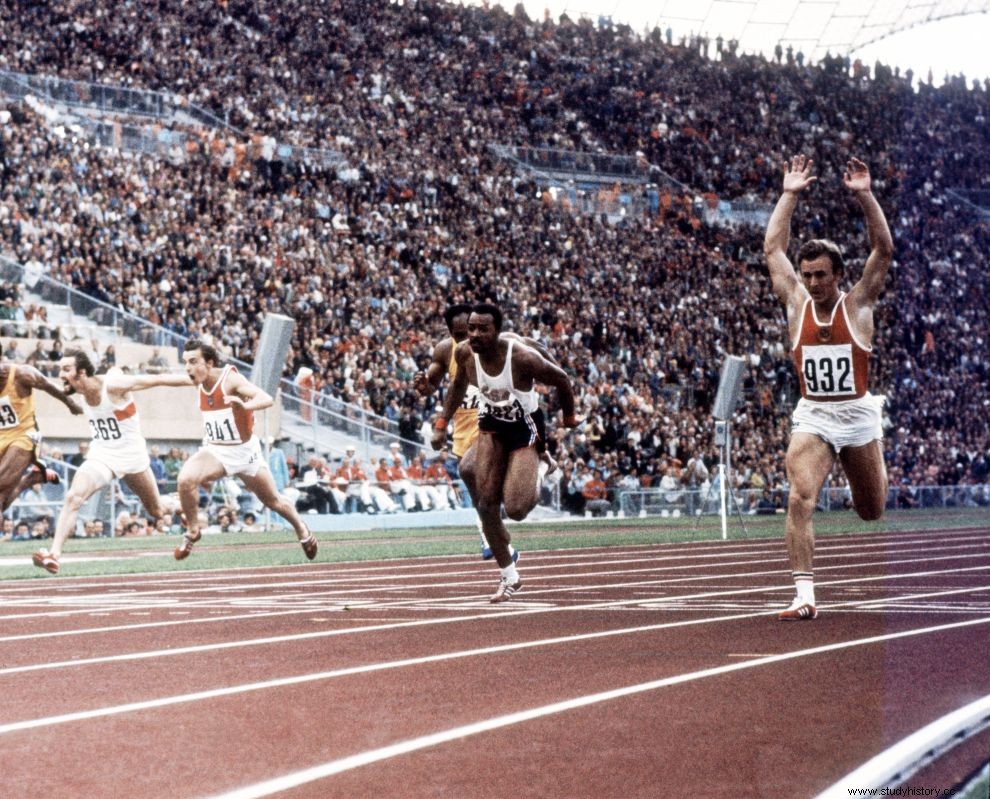
Four years later, in Munich , we had for the first time the use of the portable color camera, which with its light weight (always compared to the fixed black and white, unliftable cameras) made it much easier to move the cameras during the match, either inside the stadiums or outside of these, in any other open space competitions were held. Another very important technological addition was the presence of the camera-robot, especially in the cases where they moved on rails during the sprints. In 1972 and also in 1976 in Montreal, satellite connections were perfected, which was certainly the most important step, so that the signal could reach every corner of the world immediately and without problems.
By 1980, the television signal coupling system had been completed through a series of satellites, which now covered the Atlantic, Pacific and Indian oceans, while they had the ability to connect automatically to a series of smaller satellites that only served certain countries. But in 1972 in Munich, we had yet another new element, which although had nothing to do with sports, was a new starting point in the perception of information and the power of the television image in what we call live broadcasting.

The Black September terrorist attack on the Olympic village and the murder of eleven Israeli athletes, literally online for 48 hours through the television receiver, laid the foundation for a completely new approach to the possibility of "participation" of the television viewer in the "field of action". , opening hitherto unexplored journalistic avenues and raising a series of very subtle questions about the limits of the freedom of the image always in relation to the subject it conveys to the television audience.Another new technology that timidly made its appearance in 1968, improved significantly in 1972 and 1976 and perfected in 1980 in Moscow and even more in 1984 in Los Angeles, was the famous replay, that is the possibility of the viewer to see again the effort of an athlete or an entire race etc.
As the years went by, the replay was enriched with slow motion, the familiar slow motion to all of us. The Americans went one step further, presenting super slow motion in 1984, in its original form, of course, which had nothing to do with the current equivalent. At the same event we saw even smaller cameras, equipped with the CCD (Charged-coupled device) system, "coupled charge arrangement" in Greek, which now enabled digital processing, resulting in even higher image quality. In 1988 in Seoul, computer graphics were also perfected, which made watching the matches on television even more complete.
THE ZENITH OF TELEVISION IN THE 80s AND 90s
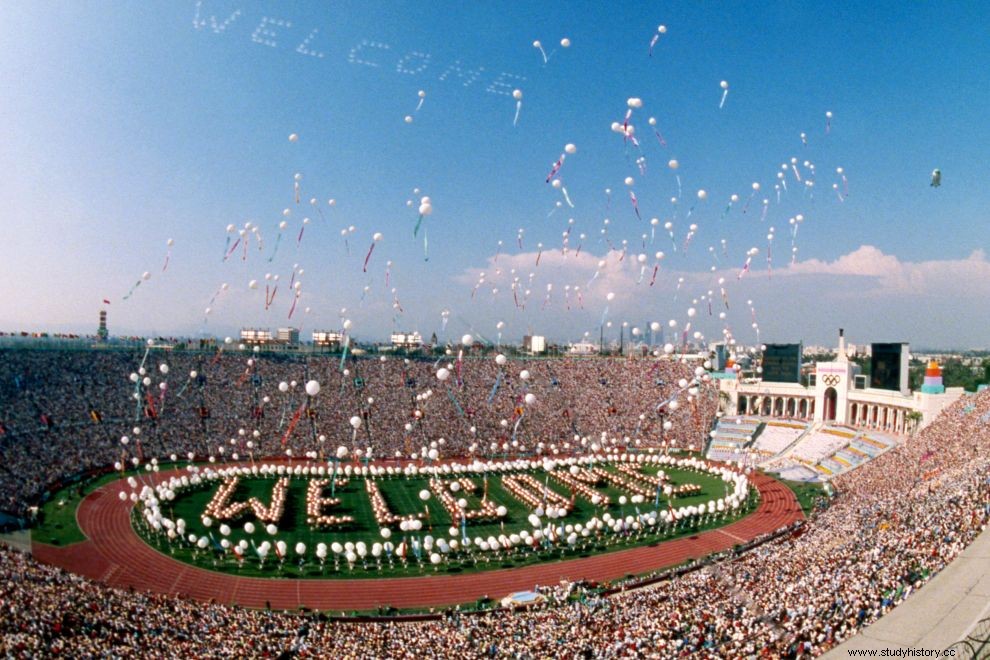
Παράλληλα, αυξανόταν συνεχώς και ο αριθμός των τηλεθεατών, ο οποίος το 1984 πλησίασε για πρώτη φορά το ένα δις (900 εκατομμύρια), για να φτάσει οκτώ χρόνια αργότερα, το 1992 στη Βαρκελώνη, τα τριάμισι δισεκατομμύρια! Στο Λος Άντζελες έγινε και η περίφημη αντιστροφή αυτού που αναφέραμε λίγο πιο πάνω, είχαμε δηλαδή για πρώτη φορά περισσότερες χώρες που μετέδωσαν τηλεοπτικά τους Ολυμπιακούς, από αυτές που πήραν μέρος στους αγώνες (156-140 με 14 να απέχουν λόγω του μποϊκοτάζ). Οι αγώνες του 1984 απέφεραν σημαντικά κέρδη για τους διοργανωτές (για πρώτη φορά μεταπολεμικά), κυρίως λόγω της σωστής διαχείρισης των τηλεοπτικών δικαιωμάτων αλλά και της μαζικής εμφάνισης ιδιωτικών χορηγών.
Η εμπορευματοποίηση σε τόσο μεγάλο βαθμό έκανε για πρώτη φορά την εμφάνισή της και από εκείνο το σημείο και μετά είχαμε μια κατακόρυφη άνοδο στα ποσά που ζητούσε η ΔΟΕ από τα τηλεοπτικά κανάλια για να παραχωρήσει τα δικαιώματα, κάτι που πολύ γρήγορα οδήγησε στο άλλο άκρο, δηλαδή στην υπερβολή και τον άκρατο πλουτισμό, με τη Διεθνή Ολυμπιακή Επιτροπή να κρατάει για λογαριασμό της πάνω από το 50% των εσόδων, ενώ μέχρι το 1980 περιοριζόταν στο 2% με 4%! Με το πέρασμα των διοργανώσεων, οι καινοτομίες δε σταμάτησαν να κυριαρχούν σε ένα πεδίο που όσο υπερβολικό και αν ακούγεται, έμοιαζε κυριολεκτικά "ανεξερεύνητο".
Το 1988 στη Σεούλ, άρχισαν να εφαρμόζονται ευρέως οι οπτικές ίνες για τη μεταφορά του τηλεοπτικού σήματος, ενώ το 1992 στη Βαρκελώνη, οι σχολιαστές της τηλεόρασης είχαν για πρώτη φορά στη διάθεσή τους το περίφημο CIS (download information system), με το οποίο μπορούσαν να έχουν πρόσβαση μέσα σε ελάχιστα δευτερόλεπτα σε πληροφορίες που χρειάζονταν για τη ζωντανή μετάδοση (λίστα συμμετεχόντων, προσωπικές επιδόσεις, στατιστικά, ρεκόρ κλπ). Στην τηλεοπτική κάλυψη των αγώνων του 1992, οι γραφίστες-προγραμματιστές είχαν καταφέρει πλέον να προσθέσουν, πέρα από τις ζωντανές εικόνες, επαναλήψεις σε αργή και σούπερ αργή κίνηση, χρονομέτρηση, τα ονόματα των συμμετεχόντων, τη σημαία και τα αρχικά της κάθε χώρας, τα αποτελέσματα και τα ολυμπιακά και παγκόσμια ρεκόρ.
ΚΑΛΩΔΙΑΚΗ ΤΗΛΕΟΡΑΣΗ &ΙΝΤΕΡΝΕΤ
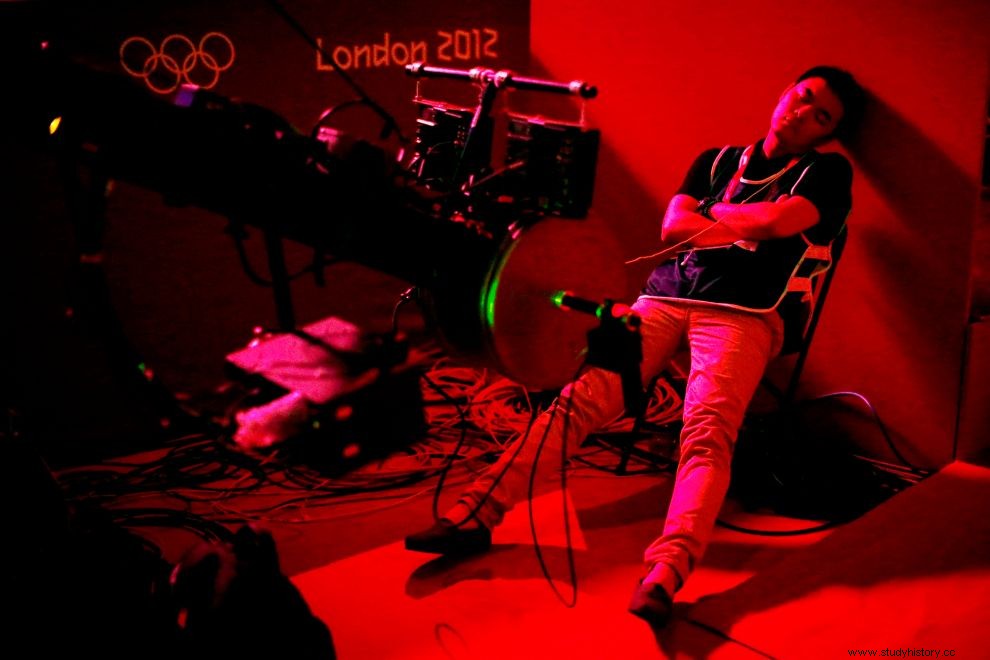
Παρ' όλες όμως αυτές τις επιτυχίες, ο "κίνδυνος" παραμόνευε και δεν άργησε καθόλου να βγει στην επιφάνεια με τη μορφή δυο "εχθρών". Ποιοι ήταν αυτοί οι "εχθροί" που σταμάτησαν την ανοδική πορεία της τηλεοπτικής κυριαρχίας στους Ολυμπιακούς; Ο πρώτος ήταν ο άνισος - όπως αποδείχθηκε - ανταγωνισμός από τις καλωδιακές τηλεοράσεις και ο άλλος - πολύ πιο επικίνδυνος - το διαδίκτυο. Το 2000 στο Σίδνεϊ, το αμερικανικό NBC κατέγραψε τους χαμηλότερους αριθμούς τηλεθέασης από το 1968! Πτώση όμως στη συγκεκριμένη διοργάνωση παρουσίασε η συντριπτική πλειοψηφία των ελεύθερων καναλιών που μετέδιδαν τους αγώνες.
Η ολοένα και μεγαλύτερη παρουσία των ιδιωτικών σταθμών που διαχειρίζονταν καλωδιακά κανάλια με συνδρομή, έστειλε τον ανταγωνισμό σε δυσθεώρητα ύψη, αφού έτσι κι αλλιώς, τα ποσά που απαιτούσε πλέον η ΔΟΕ για την παραχώρηση των δικαιωμάτων, είχαν ξεφύγει από κάθε λογική, όριο και μέτρο. Οι "αθάνατοι", με μοναδικό γνώμονα την απληστία τους, αδιαφορούσαν για όλα τα υπόλοιπα, αρκεί να συσσώρευαν κέρδη στην Ελβετία. Από την άλλη μεριά, η παρουσία του διαδικτύου, στο οποίο οι ενδιαφερόμενοι μπορούσαν να μαθαίνουν τα αποτελέσματα, αλλά και να έχουν εικόνα σε πραγματικό χρόνο, έκανε τα πράγματα ακόμα δυσκολότερα. Το πανίσχυρο όμως τηλεοπτικό λόμπι των ΗΠΑ , κατάφερε να βρει λύσεις και να βγει από το αδιέξοδο.
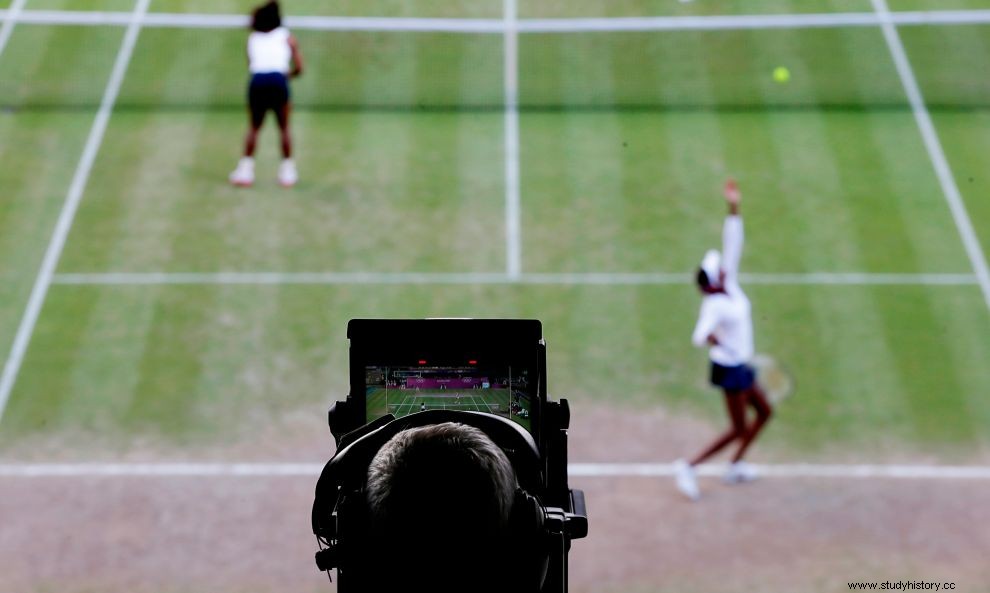
Η πίεση που άσκησε στη ΔΟΕ υπήρξε συνεχής και αφόρητη. Και οι "αθάνατοι", συνειδητοποιώντας ότι η ισορροπία πάνω στην οποία έχτιζαν τις δικές τους - οικονομικές - φιλοδοξίες, είχε σαφώς διασαλευτεί, προχώρησαν σε συγκεκριμένες παραχωρήσεις, οι οποίες βοήθησαν στην επανάκαμψη της τηλεοπτικής κυριαρχίας στη μετάδοση των Ολυμπιακών αγώνων. Οι αλλαγές που έγιναν στο πρόγραμμα των αγώνων, όπως η αύξηση των αγωνιστικών ημερών αρκετών δημοφιλών αθλημάτων όπως η κολύμβηση και η γυμναστική, αλλά και το προνόμιο του NBC να αποφασίζει (ή ακόμα καλύτερα να επιβάλλει) αυτό στην ουσία την ώρα διεξαγωγής συγκεκριμένων αγωνισμάτων (των πιο δημοφιλών προφανώς, όπως για παράδειγμα ο τελικός των 100 μέτρων), έτσι ώστε η ζωντανή τους μετάδοση να συμπίπτει με το τηλεοπτικό "prime time" των ΗΠΑ, έφεραν τα προσδοκώμενα αποτελέσματα.
Η τηλεθέαση από το 2004 και μετά παρουσίασε αύξηση μεγαλύτερη του 20% τόσο στην Αθήνα όσο και στο Πεκίνο, ενώ οι αγώνες του 2012 στο Λονδίνο είχαν τη μεγαλύτερη συνολική τηλεθέαση (στις ΗΠΑ αλλά και στον υπόλοιπο κόσμο) στην ιστορία του θεσμού. Φυσικά όλο το "κόλπο" ήταν η εκ νέου προσέλκυση των διαφημιζόμενων εταιρειών και προϊόντων, που βλέποντας μεγαλύτερη σε διάρκεια παρουσία των δημοφιλών αθλημάτων και μετάδοση των σημαντικότερων τελικών στην ώρα αιχμής, δε δίστασαν να γεμίσουν ξανά τα τηλεοπτικά κανάλια με υπέρογκα ποσά, κλείνοντας με αυτόν τον τρόπο την "τρύπα" που είχε κάνει την εμφάνισή της τα προηγούμενα χρόνια.
Η ΤΗΛΕΟΡΑΣΗ ΣΤΟΥΣ ΑΓΩΝΕΣ ΤΟΥ 21ου ΑΙΩΝΑ
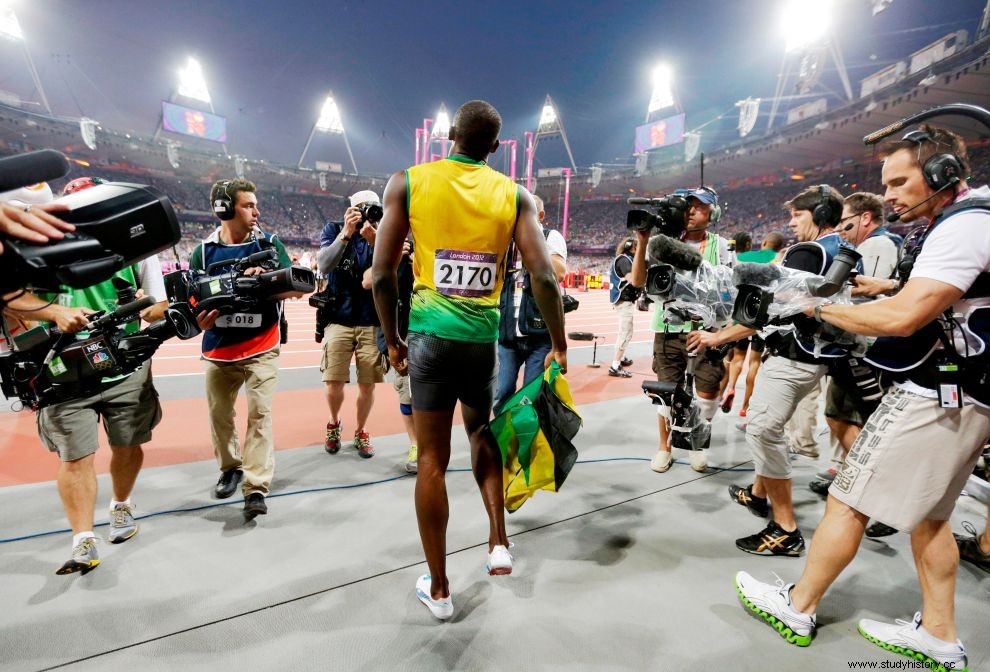
Πλέον η "ισορροπία" έχει επανέλθει και οι ίδιοι οι τηλεοπτικοί σταθμοί, με τις τσέπες και πάλι γεμάτες, μπορούν να "συνεργαστούν" χωρίς ανησυχία (προς το παρόν τουλάχιστον) με τον άλλο "εχθρό" που όπως είπαμε, προέκυψε τα τελευταία χρόνια. Η τηλεόραση, από τη στιγμή που δε γίνεται ούτε να αψηφήσει, ούτε να πολεμήσει το ίντερνετ, είναι έτοιμη να το αφομοιώσει και να το εκμεταλλευτεί με κάθε δυνατό τρόπο, ανοίγοντας μια νέα, παράλληλη πορεία συνύπαρξης μαζί του. Έτσι κι αλλιώς, οι νέες τεχνολογίες έχουν ήδη ενσωματωθεί στις λεγόμενες έξυπνες τηλεοράσεις (smart TV) και οι απώλειες με αυτόν τον τρόπο ελαχιστοποιούνται, αφού η "συνεργασία" ανάμεσα στο παραδοσιακό και το καινοτόμο είναι μια πραγματικότητα.
Έτσι λοιπόν, οι συνδυασμένες δυνατότητες που προσφέρουν οι σύγχρονοι τηλεοπτικοί δέκτες, δεν έχουν να ζηλέψουν τίποτα από ένα κινητό, ένα tablet ή ένα laptop (εξαιρώντας μόνο την πρακτική πλευρά του μεγέθους). Το 2016, στους Ολυμπιακούς του Ρίο, είδαμε την εφαρμογή ακόμα περισσότερων νέων τεχνολογιών:μέρος των αγώνων - ανάμεσά τους και οι τελετές έναρξης και λήξης - μεταδόθηκε για πρώτη φορά σε εικόνα υψηλότατης ευκρίνεια ς (ultra high definition, 8K UHD), καθώς και μέσω πανοραμικών βίντεο εικονικής πραγματικότητας. Η συνολική τηλεοπτική διάρκεια των αγώνων (που πλησίασε τις 7.000 ώρες), μεταδόθηκε παγκοσμίως σε εικόνα HD, 1080p και ήχο surround 5.1 καναλιών.
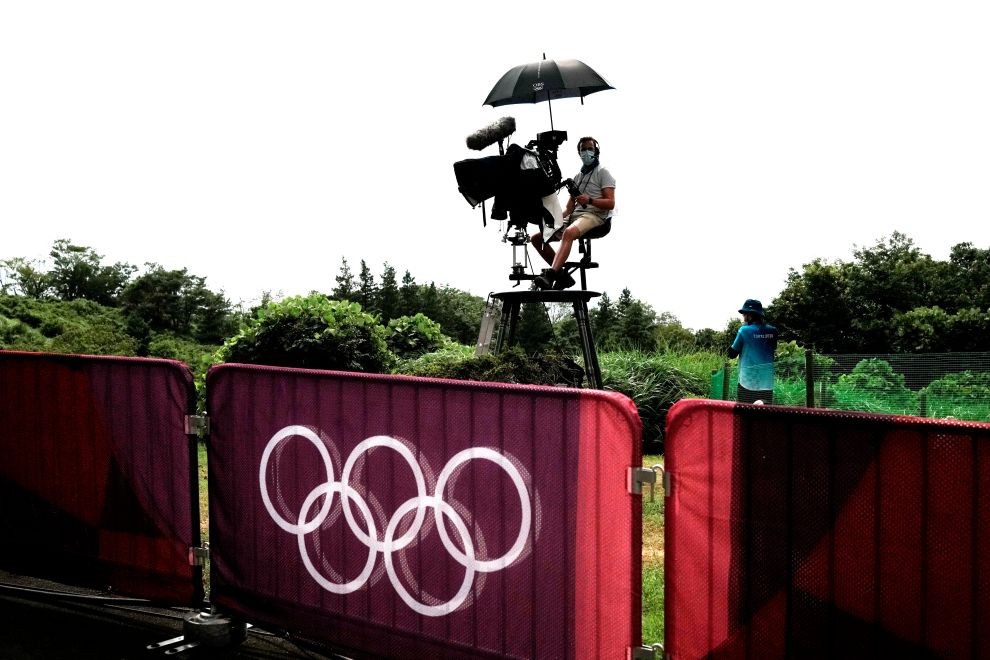
Φέτος, στο Τόκιο, όλοι οι δείκτες πηγαίνουν προς τα πάνω. Στην Ιαπωνία, η τηλεοπτική κάλυψη των αγώνων θα είναι σχεδόν διπλάσια από εκείνη του Ρίο. Στις ΗΠΑ, η NBCUniversal θα προσφέρει περισσότερες από 7.000 ώρες μεταδόσεων (τηλεόραση και ψηφιακές πλατφόρμες), ολυμπιακό ρεκόρ για τη χώρα. Στην Ευρώπη, το Discovery Eurosport θα ξεπεράσει τις 4.000 ώρες ζωντανών συνδέσεων με τηλεοράσεις και ψηφιακές πλατφόρμες 50 διαφορετικών κρατών, κάτι που επίσης αποτελεί ρεκόρ για την ήπειρό μας. Η OBS (Olympic Broadcasting Services), η αρμόδια δηλαδή εταιρεία παραγωγής, έχει δημιουργήσει μια σειρά ψηφιακών "εργαλείων" ως μέρος του πρότζεκτ "Share the Passion", τα οποία επιτρέπουν στους αθλητές να έχουν επαφή με τους φίλους τους και τις οικογένειές τους, αλλά και στους φίλαθλους από όλον τον κόσμο να υποστηρίζουν ενεργά τα αθλητικά είδωλά τους.
Το "Fan Video Matrix", το "Cheer Map" και το "Athlete Moment - Family &Friends" είναι τα σημαντικότερα από αυτά. Η OBS θα ξεπεράσει φέτος τις 9.000 ώρες συνολικής τηλεοπτικής παραγωγής, περίπου 30% περισσότερες από το Ρίο. Για πρώτη φορά στην Ολυμπιακή ιστορία, ολόκληρη η κάλυψη μεταδίδεται σε εικόνα υψηλότατης ευκρίνειας (ultra high definition, 4K, HDR) και ήχο Immersive Audio 5.1.4 καναλιών. Το τηλεοπτικό κοινό θα έχει στη διάθεσή του για πρώτη φορά λήψεις από ατελείωτες διαφορετικές γωνίες, replay 360 μοιρών, πολυκάμερες ζωντανής Virtual Reality (εικονικής πραγματικότητας) κάλυψης και πολύ περισσότερα αναλυτικά δεδομένα από κάθε προηγούμενη διοργάνωση, επεξεργασμένα από AI (Artificial Intelligence, τεχνητή νοημοσύνη). Καθόλου άσχημα για μια ιστορία που άρχισε να εξελίσσεται εδώ και μόλις 85 χρόνια, δε συμφωνείτε;
